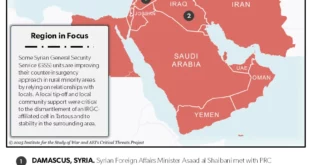Just two weeks after President Donald Trump triumphantly declared the “100 percent” defeat of ISIS’s caliphate, his national security advisor, John Bolton, admitted on television that “the ISIS threat will remain” and that this explained why a small “observer force” would now stay in Syria.
Next, senior administration officials announced that 200 U.S. troops are set to stay in northeastern Syria as part of a “multinational observer force,” with another 200 to remain in al-Tanf, an encampment near the border with Iraq, to deter Iranian behavior. Then on March 17, the Wall Street Journal reported that the U.S. military was “crafting plans to keep nearly 1,000 forces in Syria” in what the newspaper described as “a decisive shift away” from Trump’s order to withdraw.
This is the hopeful story that hawks within the Trump administration are selling. Indeed, the media appears to have become the platform of choice for the many serving government officials who are trying to coerce a reversal in Syria policy. The reality is in fact more complex and less promising.
First, the Tanf deployment depends heavily on Jordanian support, which is far from guaranteed given the Jordanian government’s intensive investment in re-engaging with the Assad regime. In Iraq meanwhile, U.S. troop levels remain the same, but a new Iran-backed campaign is underway in parliament to eventually force America’s departure.
Second, if the president has conceded that U.S. troops should stay engaged in an anti-ISIS operation in Syria – and there is not yet any evidence that he has – this would have been solely in the hope that doing so would convince European allies to fill in the shoes of the 1,600 or more American troops set to withdraw. After all, President Trump has made his opinions on Syria very clear: The victory against ISIS has been won and what’s left as far as the United States is concerned is “sand and death.” According to conversations I’ve had with European officials, the most likely allies to fill this vacuum, Britain and France, have both declined, though they have not decided to remove their existing forces – yet. Others, such as Germany, have no intention to contribute armed forces and question the value of investing heavily in stabilization measures that take place within an unclear strategic environment. There are also moves underway in London to make any continued Syria deployment contingent on a parliamentary vote, which would almost certainly suffer defeat.
As such, all “policy shifts” and “course reversals” reported in the media are in fact merely new ideas proposed by working officials who are grasping to find a middle-ground that sits somewhere in-between a full withdrawal and what is likely a temporary residual force. None of these new ideas is policy until President Trump signs off. That chairman of the Joint Chiefs Gen. Joseph Dunford took to the public late on March 17 to refute reports such as the Journal’s underlined that crucial distinction.
So long as no other governments step up to replace the departing American troops, the U.S. will be forced to continue to shoulder the burden in Syria, virtually guaranteeing a return to a full withdrawal. With the U.S. 2020 election cycle slowly kicking into gear, and despite domestic polling showing a majority of Americans actually favor remaining engaged militarily in Syria, President Trump remains highly unlikely to back something that he campaigned so strongly against and has remained committed to ending ever since. And with that black cloud hanging over Syria and the fight against ISIS, no foreign ally is likely to put its faith into what looks, to all extents and purposes, like untenable ideas presented to them by U.S. officials who ultimately still matter little in comparison to their commander-in-chief.
Worse, still, is the fact that ISIS lives on despite the president’s claims to the contrary. In Iraq, ISIS attacks are rising month-on-month after a to-be expected winter lull. In February, ISIS conducted an average of four attacks every day; Mosul has been hit by multiple car bombs in recent weeks; and most rural areas liberated from ISIS have been abandoned, left lying in ruins. Next door in Syria, ISIS’s last sliver of territory in Baghouz amounts to little more than a quarter of a square kilometer, but the group’s battle lines have barely changed after five weeks of fighting. Elsewhere, the jihadist group still runs night-time checkpoints across eastern Syria; deadly attacks are on the rise and intricate networks of sleeper cells lie in waiting. At this point in time, no force in either Syria or Iraq appears capable of effectively containing or defeating this persistent threat.
That ISIS may never be entirely defeated might be a bitter pill some—including, unless he is truly delusional about the group’s defeat, the president—are willing to swallow. Some proponents of this attitude have suggested ISIS is “defeated enough” to secure our immediate security interests.
How soon we forget the lessons of the recent past: The exact same logic drove the decision-making behind the U.S. withdrawal from Iraq in 2010-11, but ISIS’s predecessors (the Islamic State in Iraq, or ISI), were several steps into an aggressive recovery by mid-2012. Over the past two decades, the U.S. has become impressively adept at achieving military gains against terrorist groups, but whether in Iraq or Afghanistan, Syria or Yemen, it has come up short every time when it came to translating tactical victories into strategic defeat.
More worrying still is the fact that every new cycle in this process seems to bring even more potent threats. The ISIS of the future could be just as bad if not bigger and worse than the one we watched dramatically expand in 2014. In Iraq, nearly 20,000 ISIS detainees currently lie in prison and tens of thousands more who are accused of having maintained ties to ISIS lie in squalid camps surrounded by hostile security forces. A further 20,000 Iraqi ISIS prisoners and family members currently in Syria look set to be transferred back to Iraq in the coming weeks, all of whom will surely meet a similar fate: prison or secured camps. If that were not bad enough news, tens of thousands of Iraqi children born under ISIS rule look set to remain stateless due to Baghdad’s continued refusal to recognize their ISIS-produced birth certificates or to produce Iraqi replacements. All told, that may amount to at least 100,000 people in Iraq with ties to ISIS whose bleak futures will undoubtedly fuel long-term radicalization.
Syria, meanwhile, is certain to be mired by instability for years to come. Tens of thousands of Syrians displaced amidst fighting with ISIS remain in camps, many of which have been described to me by NGO officials as “internment camps” due to the harsh restrictions placed upon Sunnis who had lived under ISIS. When looking solely at the final battle over ISIS’s last village in Baghouz, at least 55,000 people living under ISIS have moved into a single camp; at least 5,000 more ISIS fighters and family-members remain in Baghouz itself to this day. As of now, roughly 7,000 ISIS militants are in the custody of the U.S.-backed Syrian Democratic Forces (SDF), including at least 1,000 foreign fighters and thousands more of their relatives, most of whom are unlikely to repatriated to their countries of origin. Whereas Iraq’s strategy appears to be long-term internment, there is no plan at all in Syria. The SDF lacks the resources to police its network of makeshift prisons for much longer and has reportedly warned that it may eventually need to release hundreds if not thousands of ISIS fighters and relatives. In March 2019 alone, hundreds of ISIS fighters have been released by the SDF into eastern Syria and many more are smuggling themselves into other lawless parts of the country.
Only days ago, U.S. Special Envoy for Syria Affairs Jim Jeffrey told the media that another 15,000 to 20,000 ISIS sleeper-cell operatives remained in play across Iraq and Syria. Though that number should be approached with some skepticism, it remains undoubtedly true that very large numbers of ISIS fighters will have melted away amidst fighting in recent years.
Beyond numbers, both Syria and Iraq display all of the same social, communal, ethnic and sectarian divides that allowed ISIS’s seeds to so dramatically take root in 2011. In fact, many are far worse today than before. Notwithstanding their parents, tens of thousands of children who grew up under ISIS rule and were indoctrinated into its hateful ideology now have little to no life prospects. In Syria’s Deir ez-Zour province alone, 40,000 children look set to receive no support whatsoever to help them heal from their ISIS experience. Extremist groups like ISIS tend to have great success in recruiting such rootless, hopeless young men and women—after all, they have little to lose and often find a powerful source of meaning in joining the cause.
To proclaim victory and withdraw at this point is not just naïve; it is dangerous. Drawing down into an ill-thought out mission merely for the sake of staying is unlikely to do much good either. Leaving other actors – either allies or adversaries – to deal with ISIS alone is not a more cost-effective strategy; it is a dereliction of the duty to protect American interests. Long-term military deployments abroad have undoubtedly become deeply unpopular, as have missions defined using terms such as “stabilization.” But abandoning hard-fought gains against ISIS at this point guarantees the group’s survival and almost certain revival into a deeply dangerous terrorist actor that will inevitably threaten regional and global security once again. This is a lesson we should have learned already. Will it take another tragedy for us to learn it again?
 Eurasia Press & News
Eurasia Press & News


